Finding the right placement for your bonsai can feel like a delightful puzzle! For a Formal Upright style, think balanced branches and a triangular silhouette. If you’re crafting an Informal Upright, lean into gentle curves and asymmetry. Want something unique? The Literati style thrives on a slender trunk with minimal foliage up top. A multitrunk design? Position those trunks to mimic nature’s cozy clumps. Intrigued by how these styles can elevate your space? Let’s explore more together!
Quick Takeaways
- For Formal Upright style, place the first branch a fourth of the way up for balance, ensuring an elegant triangular silhouette.
- In Informal Upright design, create gentle curves and maintain apex alignment for stability, with ample sunlight for branch movement.
- Literati style emphasizes a slender trunk with minimal foliage; use simple pots and backgrounds to highlight open verticality.
- For Multitrunk style, position trunks close at the base with varied thickness for a natural look, evoking a forest ambiance.
- General care involves placing bonsai near a south-facing window, rotating regularly, and maintaining consistent temperature and humidity for healthy growth.
Formal Upright Style (Chokkan) Placement Tips

Start with that first branch, about a fourth of the way up, growing outwards for balance.
And recall, branches should alternate like a good dance partner, evenly spaced to create that lovely triangular silhouette.
To achieve a truly stunning formal upright look, consider choosing Acer palmatum as your species, known for its upright growth and beautiful autumn foliage.
The roots, or nebari, need to be firmly grounded, too, giving your bonsai that sense of stability and power.
Isn’t it rewarding to see your tree elegantly representing strength?
Now go give your bonsai the spotlight it deserves!
Informal Upright Style (Moyogi) Placement Tips
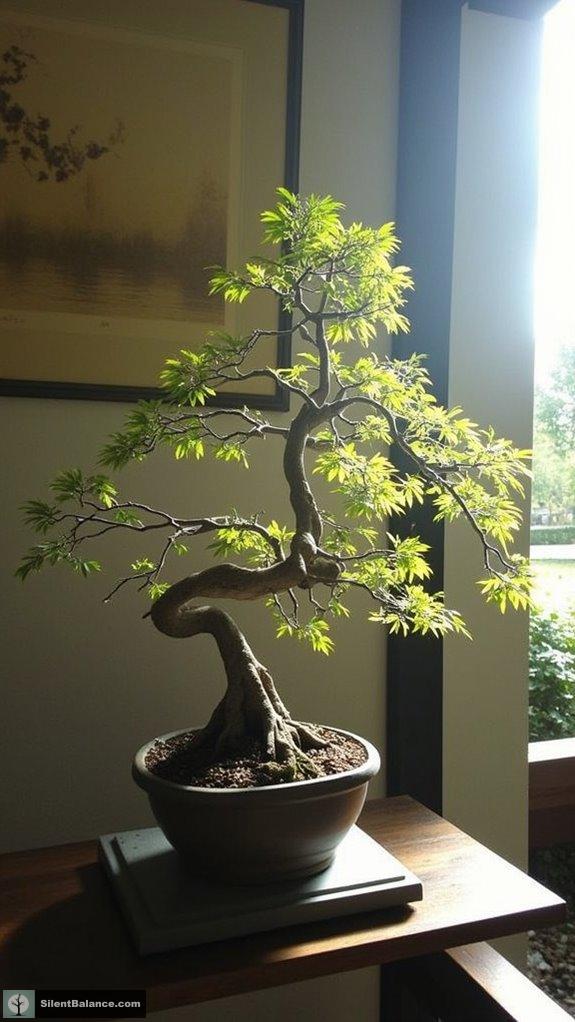
When you’re working with the Informal Upright Style, or Moyogi, the beauty lies in its subtle elegance—like a dancer gracefully swaying to the rhythm of the breeze.
This style thrives on gentle curves and balanced asymmetry, so find a spot where the tree can wiggle its branches in soft indirect sunlight. Additionally, it’s important to choose species suitable for Moyogi such as maples or junipers, ensuring they flourish in your care. Trees symbolize interconnectedness and the value of all living beings, making their placement a reflection of nature’s harmony.
Ensure that your tree’s apex proudly aligns above the base despite its bends, and keep in mind, branches should emerge from those gentle curves, adding a playful asymmetry that feels natural.
In doing so, you’ll respect its roots and give it the stability needed to withstand a breeze—after all, a strong root flare adds character!
Ready to embrace this artistic journey? Let’s make magic together!
Literati Style (Bunjingi) Placement Tips

With the graceful curves of the Informal Upright Style behind us, let’s shift gears to the enchanting world of Literati Style, or Bunjingi.
Here, it’s all about that singular, slender trunk holding our attention—embracing elegance while curving dramatically.
Keep foliage minimal, mostly crowning the top third, and let those lower branches hang around like a distant recollection.
Opt for shallow, muted pots in earthy tones; who needs distractions in this zen garden, right?
When placing your tree, think openness and verticality—let it breathe!
Maybe display it against a simple wall or subtle nature scene, drawing the eye up.
And don’t forget, patience is key.
This elegant style isn’t just a bonsai; it’s art that grows over time! Incorporating elements of tranquil zen design enhances the calming effect of your Literati arrangement.
Multitrunk Style (Kabudachi) Placement Tips
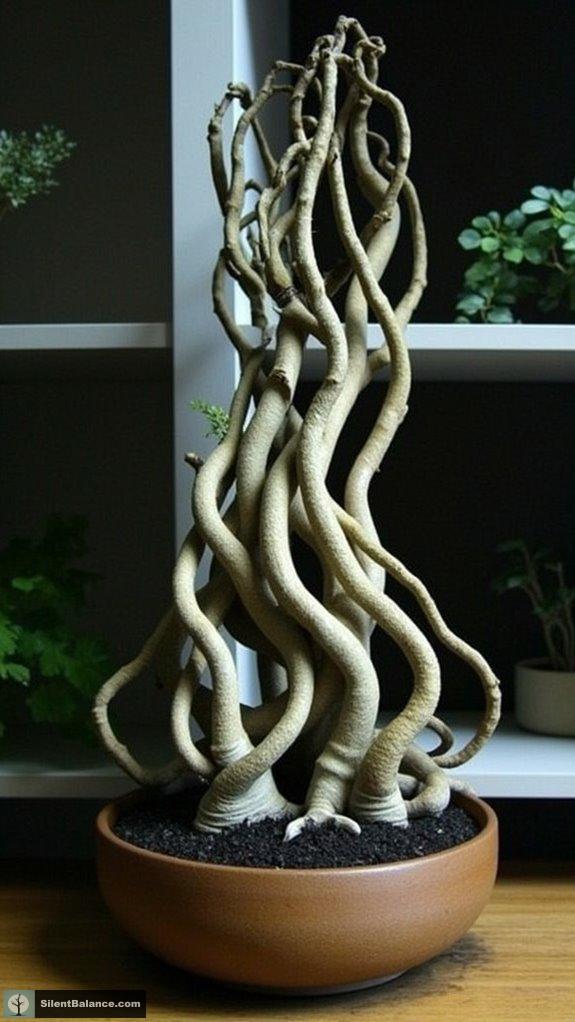
Creating a stunning Multitrunk Style bonsai, or Kabudachi, can be a thrilling journey—imagine weaving multiple trunks into a mesmerizing masterpiece that mimics nature’s quirky clumps!
To kick things off, position your trunks close enough to fuse at the base while placing them centrally for balance. A pot that’s roomy enough for all those roots is essential—no one wants a crowded party in there!
As you arrange your trunks, mix up thickness and height for that natural asymmetry.
And don’t be afraid to let them radiate outwards, simulating a genuine forest vibe.
Double Trunk Style (Sokan) Placement Tips
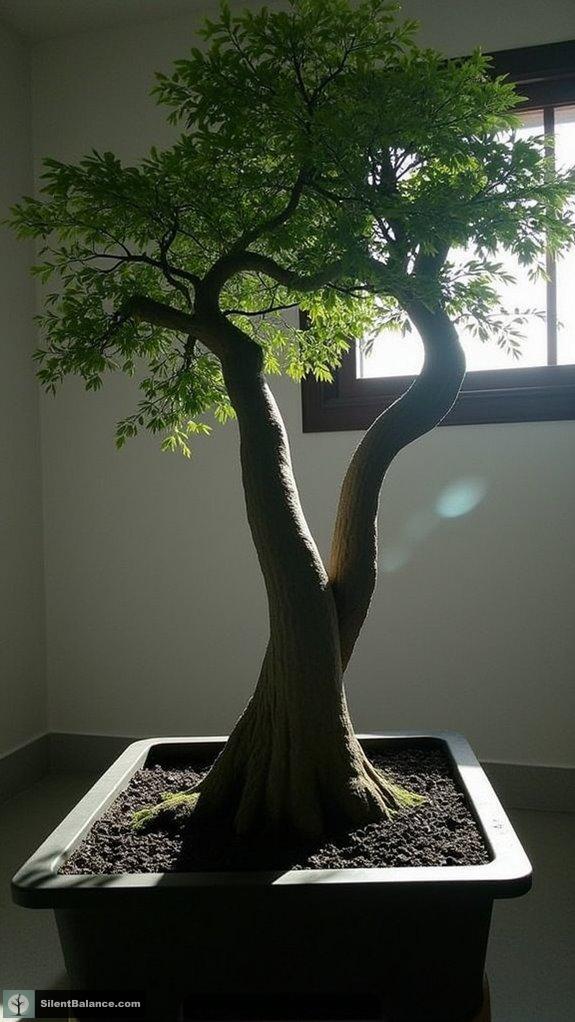
Ever wonder how to truly showcase the beauty of a Double Trunk Style bonsai, or Sokan?
Let’s explore the details, shall we? The trick lies in the placement of both trunks. A well-defined V-shaped split at the base draws the eye, creating harmony.
Here’s a quick guide to get you started:
| Aspect | Details | Tips |
|---|---|---|
| Nebari | Central root base for balance | Guarantee both trunks are visible |
| Trunk Size | Dominant trunk must be taller | Maintain hierarchy between trunks |
| Branch Placement | Create outward growth | Avoid crossing branches |
Forest Style (Yose-ue) Placement Tips

When you’re ready to plunge into the world of Forest Style (Yose-ue) bonsai, you’ll discover it’s all about crafting a miniature woodland that feels alive and natural.
Think about it—planting three or more trees together creates that inviting forest vibe, right? Stagger them in a non-linear pattern to avoid boring straight lines.
I love using varying trunk heights; place those taller trees in the center for a striking focal point.
Don’t forget, keeping an odd number ups the aesthetic—three or five will do the trick!
And using trees of the same species, like lovely pines or vibrant azaleas, helps maintain harmony.
Finally, let’s add some moss or tiny rocks for a charming forest floor touch, shall we?
General Placement Guidelines for Bonsai Trees
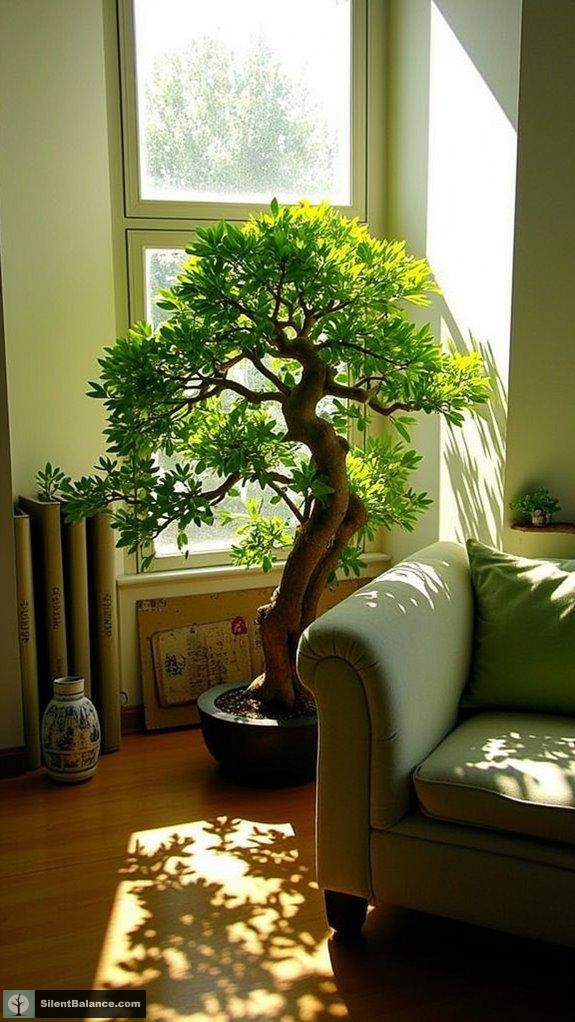
After having fun with the enchanting Forest Style (Yose-ue), let’s shift our focus to the broader scenery of bonsai placement.
Finding the perfect spot can make all the difference for your little green companion! Here are some guidelines to ponder:
- Place your bonsai near a south-facing window for maximum sunlight.
- Rotate your tree regularly, guaranteeing even growth all around.
- Keep airflow steady—avoid heat sources like radiators that can scorch those delicate leaves.
- Maintain consistent temperature and humidity; loving care fosters robust health!
Bonsai Tree Symbolism

Embracing the enchanting world of bonsai is a journey rich with symbolism, weaving a tapestry of meaning that resonates deeply with enthusiasts.
Each bonsai embodies harmony, peace, and a balance between nature and oneself. When you shape your tree, you reflect your thoughts and intentions—creating a dance between masculine strength and feminine delicacy.
Isn’t it intriguing how these living sculptures teach us patience and mindfulness through the art of care?
As seasonal changes unfold, each twist and turn of branches reminds us of life’s transitory nature, echoing Zen teachings.
And let’s not forget species-specific meanings, like the azalea, which whispers of feminine beauty and passion.
Tree Symbolism
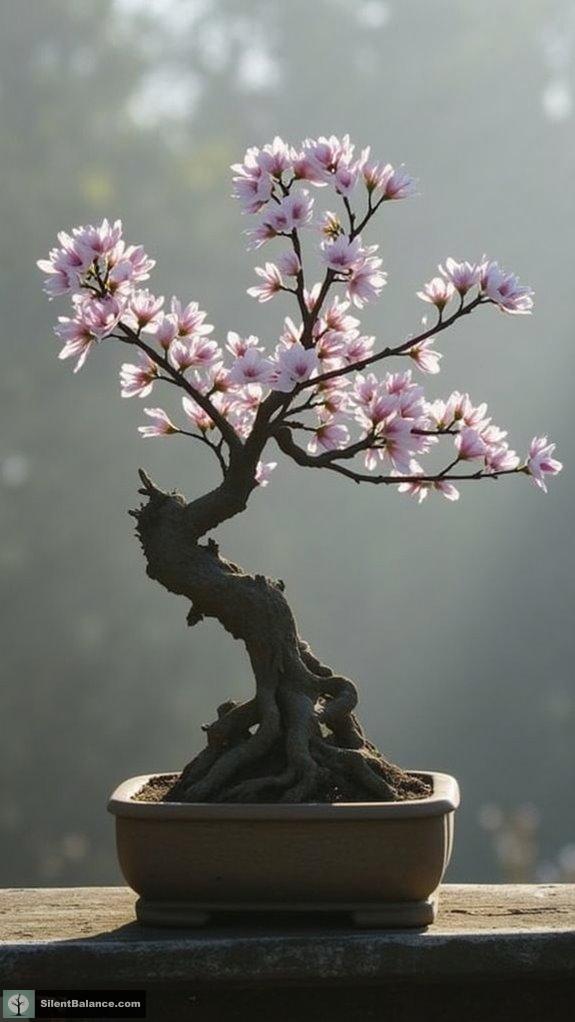
Though many might only see trees as mere plants, the truth is that they’re rich with symbolism and meaning that often goes unnoticed.
In bonsai culture, we embrace these deep-rooted meanings. Here are a few that might resonate with you:
- Cherry Blossoms: Represent impermanence and beauty, reminding us to cherish the moment.
- Baobab: A symbol of strength and endurance, nurturing our social bonds.
- Oak Trees: Think of resilience, longevity, and that comforting feeling of protection they offer.
- The Tree of Life: This connection between earth and sky embodies growth and life cycles.
Questions and Answers
How Do I Choose the Right Container for My Bonsai?
Choosing the right container for my bonsai feels personal. I consider its size, shape, and color, matching it to my tree’s features. The right pot brings out my bonsai’s beauty, creating a harmonious connection between us.
What Type of Soil Is Best for Bonsai Trees?
When I choose soil for my bonsai, I always prioritize a mix of Akadama, Pumice, and Lava rock. It’s essential for water retention and drainage, ensuring my trees stay healthy and vibrant.
Can Bonsai Trees Be Placed Outdoors Year-Round?
Absolutely, bonsai trees can thrive outdoors year-round, except for tropical species. I’ve found that providing them with sunlight and shelter from harsh weather really enhances their health and beauty throughout all seasons.
How Often Should I Water My Bonsai?
Picture a quiet pond; I gently check my bonsai’s soil each day. When it feels dry, I water deeply. It’s about understanding my tree’s needs—like nurturing a friendship, I listen and respond with care.
What Are the Signs of Overwatering in Bonsai Trees?
I’ve noticed that overwatering my bonsai leads to yellowing leaves, wilting despite moist soil, and a musty smell. If your tree’s showing these signs, it’s essential to adjust your watering routine quickly.
References
- https://abanahomes.com/blogs/news/bonsai-styles-a-detailed-guide-for-beginners
- https://cincinnatibonsai.org/bonsai-tree-style-guide
- https://www.chhajedgarden.com/blogs/all/bonsai-styles-an-overview-of-the-different-forms
- https://www.bonsaiempire.com/origin/bonsai-styles
- https://www.bbg.org/article/bonsai_styles
- https://www.bonsaiable.com/blog/formal-upright-bonsai
- https://hookedonbonsai.com/bonsai-styles-and-soil-preferences-from-cascading-to-formal-upright/
- https://www.bonsainut.com/threads/style-list.40386/
- https://www.bonsaiable.com/blog/informal-upright-bonsai
- https://orchidrepublic.com/blogs/news/discovering-different-bonsai-styles
- https://www.bonsaiable.com/blog/literati-bonsai
- https://www.bonsaioutlet.com/bonsai-articles/bunjin-bonsai-take-your-bonsai-to-extremes/
- https://www.bonsaihunk.us/info/Bunjin_literati_Style.html
- https://www.magiminiland.org/OtherArchived/Literati.pdf
- https://bonsaitoday.com/articles/basics/styles/bunjin-gi-literati-style/
- https://www.youtube.com/watch?v=2Knfmwe7njI
- https://www.bonsainut.com/threads/strategic-approach-to-bonsai-development.68251/
- https://www.youtube.com/watch?v=h9OKPxm8rZA
- https://www.bonsainut.com/threads/kabudachi-first-maple-clump.65808/
- https://brilliantbonsai.wordpress.com/2014/02/03/sokan-style-or-twin-trunk-bonsai/
- Top 10 Bonsai Tree Designs for Miniature Home Greenery - September 5, 2025
- What Are the Easiest Bonsai Tree Species for Minimal Care? - September 5, 2025
- Best Bonsai Tree Species for Outdoor Seasonal Climates - September 5, 2025

